Wu Zhen ( 1328 - 1379 )
Brothers Joining the Ranks

Admiral Wu Zhen's Mausoleum
The entrance is just left of image center
Also note the shape of the trees lining the road
Wu Zhen, born 1328 in Dingyuan, Anhui Province, had joined the rebellions against the Mongol Yuan regime in China.
Together with his brother, Wu Liang, Wu Zhen first met Zhu Yuanzhang, the future first Ming emperor, when Zhu in a lull in the battles against the Mongol Yuan army returned to his hometown to recruit 700 new soldiers. Among them would be 24 future Ming senior commanders, two of them being the Wu brothers.
At first Zhen was an intermediate commander in what was later to become the regular Ming forces. At the time around 1360, the Yangtze River basin was controlled by three warlords, almost equal in strength: Han, Wu and Ming. Each was battling for supremacy in the vacuum left behind from the failing control by the Yuan empire.
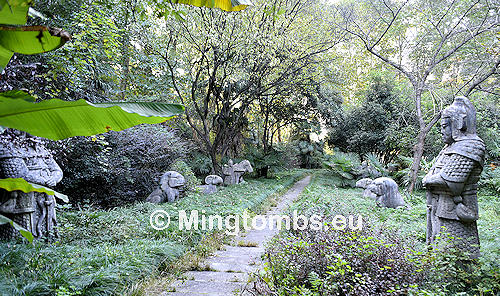
Stone statues looking south
Wu Zhen participated in many of Ming's campaigns for control of cities like Zhenjiang, Guangde, Chengzhou, Xuancheng and Jiangyin. He excelled as a commander and rose in rank.
Wu Zhen's real claim to fame however was his role in the critical maritime battle at Lake P'oyang, where Ming dealt a crushing and fatal blow to the Han state despite it having a far larger and better equipped fleet. Following this battle Wu Zhen's military career mainly became associated with the naval arm of the Ming forces.
In 1368, when Zhu Yuanzhang formally declared the Ming Dynasty (1368-1644), Wu Zhen was made minister of maritime affairs. He managed to seriously curtail the marauding operations of coastal pirates, not least those originating from the Ryukyu Islands (Okinawa), where the Ming fleet under his command succeeded in capturing many of the pirates' vessels.
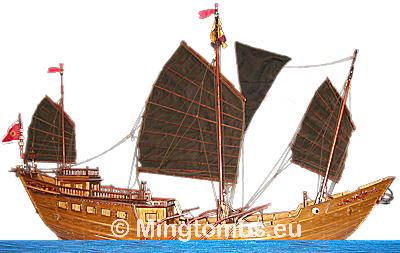
Ming vessel
Zhen's name also stood out in the initial Ming campaigns to oust the remaining Yuan forces from the north China plains. Whereas the strong Ming armies led by Xu Da, Chang Yuchun and Li Wenzhong all to some degree failed to reach their objectives, the Ming fleet under Zhen's direct command on the other hand excelled in bringing essential supplies unhindered and unscathed along the coast all the way to Shandong Province.
Wu Zhen passed away in 1379 in the Ming capital after having fallen ill during a maritime campaign around Liaoning Province. Zhu Yuanzhang bestowed him a title of Duke of Naval Affairs (Ming ocean/river territory) and a posthumous name of Xiang Yi, officially characterizing Zhen as a virtuous person, who without fail rendered outstanding service to the imperial court.
The Emperor finally granted him the ultimate honor of a burial at Zhongshan Mountain, Nanjing, the same mountain that would later serve as tomb and mausoleum of the Emperor himself.
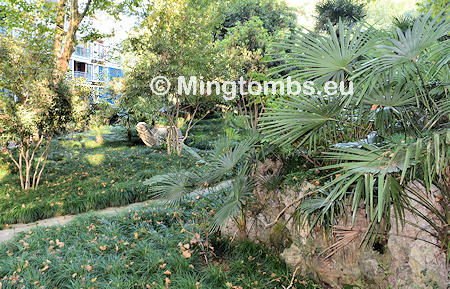
Entrance amidst apartment buildings
Protective Shield
Wu Zhen's mausoleum is located on the northern slope of Zhongshan Mountain, Nanjing. The first Ming Emperor, Zhu Yuanzhang, reigning as the Hongwu Emperor (r. 1368-98) wisely allowed his closest and very capable brothers in arms to be interred on the northern slope of the mountain. That way they formed a protective "shield" for the Emperor's own mausoleum located on the opposite side of the mountain.
Wu Zhen's mausoleum has almost been completely boxed in by factories and residential buildings and can be quite hard to locate. The mausoleum is almost oriented south to north, but the entrance has been relocated eastward to accommodate new roads and apartment blocks.
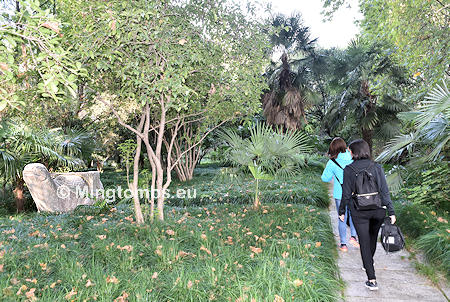
Center path with turtle left
Layout
Contrary to other smaller Zhongshan mountain mausolea, this one is equipped with a turtle traditionally carrying a stele on its back. But whereas the turtle is extant, the stele has been lost. The turtle has been placed -as is customary- close to the entrance and a little off to the left (west) from the center path of the mausoleum.
The center path, barely a meter wide, runs for about 80 meters, lined on both sides with traditional stone figures the last 30-40 meters. From south to north the four figures on each side are horse with attendant, ram, tiger and warrior.
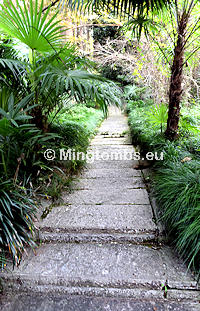
Side path
There is only a small, slightly elevated tomb mound at the end of the path. A circular hedge is placed on the top.

Well?
Halfway down the path a perpendicular 10 meter long side road leads east to a small pavilion, which contains what appears to be a grinding-type stone corn mill in its center. It is however likely the remains of a water well as it was not uncommon to include this in a mausoleum. This can for instance also be found in Li Wenzhong's mausoleum (see image here).
Overall the contents of the mausoleum is in reasonable shape with the added note that one of the warrior stone figures appears to have been replaced. Some of the figures are almost covered by vegetation and the grass carpeting most of the mausoleum could need some trimming.

Stele Turtle
Along with that of Qiu Cheng, this mausoleum is also one of the smallest occupying the northern slope of Zhongshan Mountain.
Stone Figures
The Stele Turtle
Despite being located in a small Ming mausoleum, the stele turtle surprisingly has the same size as those placed in even the grandest Ming mausolea.
It faces south in line with tradition. The stele, the purpose of which is to describe the merits of the tomb occupant, has gone missing. This is rather unfortunate as it would had been interesting to read the inscription since Wu Zhen earned most of his honors in the maritime field and not on the ground.

Eastern Horse and Attendant
Horse and Attendant
The horses are all saddled up and ready to ride with the tomb occupant, should he wish to do so. The horses are held in their reins by the attendant's left hand.
The attendant is always standing on the side of the horse facing the (non extant) tomb mound. He wears a simple, sparsely adorned robe held in place by a knotted robe and wears a helmet. He appears patient and submissive.
The horse, on the other hand, has a nicely adorned outfit, all the way from the saddle to the headgear. This is proper considering the high rank of the deceased, who is supposed to mount and ride the horse.

Horses?
As is also seen in other Zhongshan mausolea, the saddle decoration opposite of the attendant include two small, running animals. They are most likely horses, although it is hard to clearly discern, but irrespective thereof they make for a beautiful adornment.

Eastern Ram
Part of what would have been the free hanging part of the reins as well as the attendant's hand holding the reins are both missing. This could be due to vandalism or a deliberate act by rebels, who symbolically thereby prevented the deceased to ride the horse.
The western horse and attendant stone figure is almost hidden from view by the vegetation.
Ram
The ram is in a lying position facing the path on both sides. It is neatly crafted with clearly chiseled curved horns.
Rams are placed in mausolea because in Chinese mythology the animal stands for justice. Put differently, the presence of the sheep in the mausoleum ensures that only righteous people can pass.

Eastern Tiger
Tiger
Nearer yet to the northern end of the path are the tigers, one on each side. They are sitting down, resting on the hind legs and with the tail tucked in under the body.
They appear alert and ready to jump upon any one attempting to disturb the deceased.
The Asians consider the tiger protector of the dead and is therefore logically placed in mausolea in order to ensure that the tomb occupant may rest in peace and undisturbed.
The stone tigers have a solid, muscular body and the leg muscles come across as strong and able.

Eastern Soldier
The Soldiers
The last platforms lining the center pathway house the guarding soldiers. They stand erect, resting both hands on the handle of the battle sword and face the path.
They wear capes, (leather-) helmets and heavy, protective armor over most of the body. The capes are tied together with small knots.
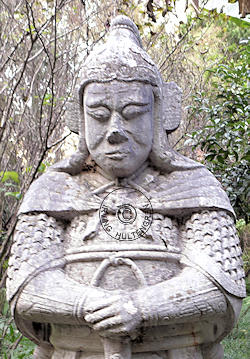
Western soldier
-No goatee-
The lower part of the breast plate, the sword and the belt carry some decoration. Part of the lower body clothing is held in place with a knotted rope, the ends of which almost reach all the way to the ground.
Also the back side of the armor is nicely decorated. The cape at the top is quite simple with only folds cut into the stone.
The eastern soldier statue appear in far better shape than its western counterpart and is most likely a replacement for the original. This newer soldier does not have a goatee like the western one.
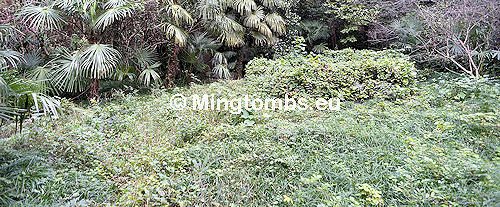
Tomb mound with marker in the rear
The soldiers appear alert and ready in all aspects to defend the mausoleum occupant if the need should arise.
The Platform and Mound
There is no trace of a stone platform, but a small and low mound is extant. The top of the mound is decorated with a small circle made of plants. Behind the mound there is a stone marker almost hidden in the vegetation.
It is uncertain whether Wu Zhen is actually interred at this exact location.